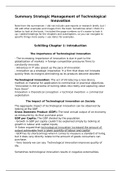Samenvatting
Summary Strategic Management of Technological Innovation (Schilling, 2019, 6th edition)
- Instelling
- Vrije Universiteit Amsterdam (VU)
This is an elaborate summary for the 2019 version of Schilling's "Strategic Management of Technological Innovation". I used examples and images from the book. Everything you need to know is in this summary.
[Meer zien]






